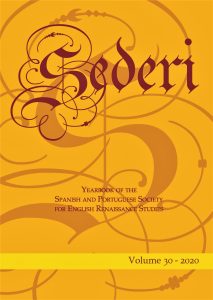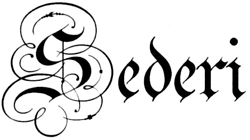
Sederi 30
Sederi 30 — 2020
EDITOR
Ana Sáez-Hidalgo
REVIEW EDITOR
María José Mora
ISSN 1135-7789
Joan Curbet Soler, “Writing and Weaving: The Textual and the Textile in Spenser’s 1590 Faerie Queene, III.i.” SEDERI 30 (2020): 47–68.
DOI: https://doi.org/10.34136/sederi.2020.3 Download PDF
Abstract
Most often, Ovidian allusions are woven into Edmund Spenser’s The Faerie Queene (Books I–III, 1590) without developing into an open re-telling of myths. One significant exception occurs in Book III, Canto 1: there the action comes to a temporary stop in order to make space for a detailed description of the tapestry in the hall of Castle Joyous, which depicts the story of Venus and Adonis. This article intends to offer a reading of that episode that focuses on the importance of materiality and self-reflexivity as keys to its significance at the opening of Book III, and in the larger structure of The Faerie Queene.
Here, the descriptive powers of the poet are both foregrounded and questioned, in a double movement of ekphrasis which gestures towards a serious interrogation of the value of representation, both in poetry and the visual arts. Implicitly, it is the poet (and through him, the reader him/herself) that must question his/her role and participation in the gradual and often painful awareness of the body that is foregrounded throughout Book III.
Keywords: Spenser; representation; “Arras” tapestries; ekphrasis; textuality; Britomart; body
References
Belsey, Catherine. 2012. “Invocation of the Visual Image: Ekphrasis in Lucrece and beyond.” Shakespeare Quarterly 63 (2): 175–98.
Berger, Harry, Jr. 1988. Revisionary Play: Studies in the Spenserian Dynamics. Berkeley: University of California Press.
Burlinson, Christopher. 2007. Allegory, Space and the Material World in the Writings of Edmund Spenser. Cambridge: Boydell & Brewer.
Campbell, Thomas P. 2007. Henry VIII and the Art of Majesty: Tapestries at the Tudor Court. New Haven: Yale University Press.
Curbet, Joan. 2001. “Repressing the Amazon: Cross-Dressing and Militarism in The Faerie Queene.” In Dressing Up for War: Transformations of Gender and Genre in the Discourse and Literature of War, edited by Andrew Monnickendam and Aránzazu Usandizaga, 157–72. Leiden: Rodopi.
Da Vinci, Leonardo. 1970. The Literary Works of Leonardo da Vinci. Edited by Jean-Paul Richter. London and New York: Phaidon Press.
Eisendrath, Rachel. 2018. Poetry in a World of Things. Aesthetics and Empiricism in Renaissance Ekphrasis. Chicago and London: University of Chicago Press.
Gilman, Ernest B. 1986. Iconoclasm and Poetry in the English Reformation: Down Went Dagon. Chicago: University Chicago Press.
Goldberg, Jonathan. 1981. Endlesse Worke. Spenser and the Structures of Discourse. Baltimore: Johns Hopkins University Press.
Goldberg, Jonathan. 2009. The Seeds of Things: Theorizing Sexuality and Materiality in Renaissance Representations. New York: Fordham University Press.
Gross, Kenneth. 1985. Spenserian Poetics: Idolatry, Iconoclasm and Magic. Ithaca: Cornell University Press.
Hard, Frederick. 1930. “Spenser’s ‘Clothes of Arras and of Toure’.” Studies in Philology 27: 162–85.
Heffernan, James A.W. 1993. Museum of Words. The Poetics of Ekphrasis from Homer to Ashbery. Chicago: The University of Chicago Press.
Hollander, John, 1988. “The Poetics of Ekphrasis.” Word and Image 4: 209–19.
Jardine, Lisa. 1996. Worldly Goods. London: Macmillan.
Krieger, Murray. 1992. Ekphrasis: The Illusion of the Natural Sign. Baltimore: The Johns Hopkins University Press.
Lewis, C. S. 1936. The Allegory of Love. Oxford: Oxford University Press.
Platter, Thomas. 1937. Thomas Platter’s Travels in England. Edited and translated by Charles Williams. London: Jonathan Cape.
Riley, E. C. 1988. “Don Quixote: From Text to Icon.” Bulletin of the Spanish Society of America 8: 103–15.
Roche, Thomas P., Jr. 1964. The Kindly Flame: A Study of the Third and Fourth Books of Spenser’s “Faerie Queene.” Princeton: Princeton University Press.
Rye, William B. 1865. England as Seen by Foreigners in the Realms of Elizabeth I and James I. London: Russell Smith.
Silberman, Lauren. 1986.“Singing Unsung Heroines: Androgynous Discourse in Book 3 of The Faerie Queene.” In Rewriting the Renaissance: The Discourse of Sexual Difference in Early Modern Europe, edited by Margaret W. Ferguson, Maureen Quilligan, and Nancy J. Vickers, 267-71. Chicago: University of Chicago Press.
Spenser, Edmund. 1997. Amoretti and Epithalamion: A Critical Edition. Edited by Kenneth J. Larsen. Tempe, Arizona: SUNY Press.
Spenser, Edmund. (1590, 1596) 2007. The Faerie Queene. Edited by A. C. Hamilton, Hiroshi Yamashita, Toshiyuki Suzuki, and Shohachi Fukuda. London: Pearson Education.
Thompson, Claud A. 1972. “Spenser’s ‘Many Faire Pourtraicts, and Many a Faire Feate’.” Studies in English Literature, 1500-1900 12: 21–32.
Wood, Rufus. 1997. Metaphor and Belief in The Faerie Queene. London: Macmillan.
